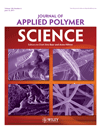Dynamic shear rheological behavior of PP/EPR in-reactor alloys synthesized by multi-stage sequential polymerization process
Abstract
The rheological behavior, morphology, and mechanical properties of in-reactor alloy of polypropylene (PP)/ethylene propylene rubber (EPR) synthesized by multi-stage sequential polymerization process are studied in this article. The relationship between polymerization parameters, morphology, and rheological properties are evaluated by scanning electron microscopy (SEM) and small amplitude oscillation rheometry in the linear viscoelastic region. The electron microscopy of samples is showed that by increasing switching frequency in polymerization time, the size of EPR particles decrease. By increasing switching frequency, the curves of complex viscosity against angular frequency of samples are shifted to higher values at low range of shear rates with no significant change at higher frequencies in Power-law region. The modified Cole-Cole plots revealed the enhanced melt elasticity by increasing switching frequency up to 230°C. The plot of phase angle versus absolute value of complex modulus G* is used for the evaluation of matrix-droplets interaction at various temperatures. It is observed two different behaviors before and after 230°C which is the evidence of the change in relaxation mechanism of the blend components because of coarsening the rubber particles in the phase separation process. © 2011 Wiley Periodicals, Inc. J Appl Polym Sci, 2011




